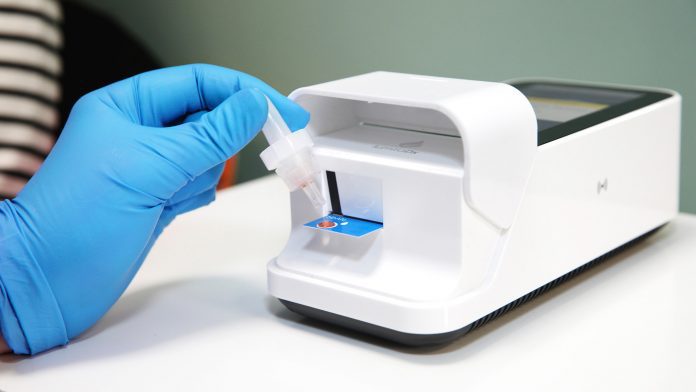
LumiraDx’s new HbA1c test, run on the LumiraDx point of care platform, could dramatically improve patient management, and reduce healthcare costs associated with delays in diagnosis and disease complications.
In light of LumiraDx’s innovative HbA1c test, Lorna Rothery spoke to Professor Garry John (GJ), Consultant Clinical Biochemist, Norfolk and Norwich University Hospital, and Dr Matt Fay (MF), Medical Director, LumiraDx, and GPwER in cardiology and cardiovascular disease, about the potential benefits of using point-of-care (POC) tests to support the identification and management of patients with diabetes.
Why are advancements in HbA1c diabetes testing so critical now?
GJ: HbA1c diabetes testing has been around for just over half a century and methods have improved a great deal within that time. All major manufacturers adhere to the IFCC standardisation and this has helped improve the quality and precision of analysis. This global standardisation has enabled targets to be set regarding diabetes diagnosis and the monitoring of individuals with diabetes. To achieve global and national targets, we need the methods we use to be reliable and accurate.
We have set ourselves some tight targets for assessing the metabolic situation of individuals with diabetes and also for diagnosing people with type 2 diabetes. These systems may in the future be invaluable in low-and-middle-income countries for diagnosis and monitoring.
How can point-of-care testing help people with diabetes to manage their condition more easily?
GJ: Point-of-care diabetes testing covers two key areas: self-testing and healthcare professionals performing analysis near the patient. Individuals using tests to monitor their diabetes has become the cornerstone of achieving good glycaemic control and enables them to feel more empowered.
Empowerment is a word that we could probably use a lot when we talk about diabetes. We empower patients to manage glycaemic control and adjust their regimes, especially people with type 1 diabetes; they can adjust their insulin regime to achieve a glucose level that is right for them. We see this more and more now with continuous glucose monitoring devices. That aspect has been fundamental in allowing individuals to achieve good control of their metabolic condition.
With decentralised diabetes testing people can go to their GP or pharmacy and have these tests done there. This is also important because it allows individuals to see their results immediately and therefore encourages them to achieve the target set out for them. It also enables the healthcare provider to be reassured that the level of improvement or control is a true representation of the metabolic situation. As clinicians, we cannot tell by simply looking at a patient what their level of glycaemia is at that point in time, or indeed over the previous two or three months.
What are some key considerations when implementing the use of POC tests?
GJ: These devices can provide a very valuable asset to healthcare providers as long as the platforms deliver the quality specifications needed. There is no point using a device in a pharmacy or care home if the quality of data is not good enough to advise the user that the situation is what it seems. Operators in every setting must be fully trained, there needs to be a continuing quality control and quality assessment or proficiency diabetes testing.
Devices may be placed in certain settings because of geography – if patients live in more remote areas and struggle to reach a test site for instance.
Basic laboratory support for clinical colleagues providing healthcare is fundamental; anything that allows our clinical teams to gather the complete information they need on the patient they are dealing with at that point in time is central to good metabolic control.
Could the availability of the LumiraDx test lead to more people getting an earlier diabetes diagnosis?
MF: We know about 7% of the population has diabetes and this figure is increasing. Likewise, all our figures would suggest that in the UK, there is probably a million people who do not know that they have diabetes. That might be because they are minimally symptomatic or, unfortunately, many would simply prefer not to take the test and know the answer. Ease of access to an HbA1c in the local chemist or community group, anywhere these tests can be set up so that patients can understand their glycaemic control, is going to be a real benefit.
While we cannot diagnose type one and type two diabetes using a point-of-care HbA1c at this time, the fact that we can identify at-risk individuals, who can then go to their clinician and get checked out, is important.
When you consider that about 10% of the NHS budget is allocated to caring for people with diabetes – and 80% of that goes towards dealing with complications associated with the disease – if patients do not know they have the disease, how can they be suitably supported and managed? Identification at the patient’s convenience, hopefully, will help us find those million people and look after their health as well as alleviate the burden on the NHS. Diagnosing more people will enable them to live well with the disease and avoid severe complications which, in turn, reduces costs for the NHS.
What are the benefits to both healthcare professionals and patients of using LumiraDx’s diagnostic platform instead of lab-based tests?
MF: The benefit to the patient is that they can have the consultation with their clinician, and the result is there immediately. They can discuss that result rather than having to make two appointments, maybe see the healthcare assistant or nurse for a blood test and then come back for a further consultation to get that result. Their management and current glycaemic control can be discussed there and then.
One of the big problems in the management of people with diabetes is clinical inertia: we have a result, and we do not act on it. This is partly because practices have got into the habit of seeing the patient to discuss results from a blood test they had months ago. Avoiding that lag in patient care means that the glycaemic control is improved, and clinicians can start talking to patients about lifestyle and how that might be improved, as well as medications that can help. There is a whole raft of new medications which bring other benefits, we can have that conversation with the patient in a single episode, they do not have to go back and forth to the practice.
People with diabetes often have multiple comorbidities and they could live their life in clinical buildings, and that is just not acceptable. If you reduce the number of contacts in the practice, that saves staff time and has massive benefits for the practice and patients overall. Time is money and GP practices are essentially small businesses.
On a larger, systems scale, anything that can break this clinical inertia will benefit the patient because they have better control, and this leads to fewer costs to the health system.
Poorly controlled diabetes leads to cardiovascular death and harm; we have fantastic teachers who are telling us how to improve diabetes care, and we are, but just too slowly.
What is the benefit of having the HbA1c on the same platform as other assays?
MF: If I have to train my staff on five different machines for five different tests, they are going to make mistakes. Whereas the fact that you have exactly the same standard on a single machine means it is easier for me to educate and train my staff; I have one good, compact machine that does everything.
If I can do a HbA1c and CRP test on the same machine, then I can treat two different types of patient. Again, we come back to those benefits of the result being there straightaway; I can discuss this with the patient and my dependency on delayed results coming back from the lab is reduced. Whether it is diabetes testing, or testing for infection, or heart failure, these devices can be of great benefit to patients and the health system overall.
More information on the LumiraDx HbA1c test may be found at: https://www.lumiradx.com/uk-en/test-menu/hba1c
This article is from issue 23 of Health Europa Quarterly. Click here to get your free subscription today.










